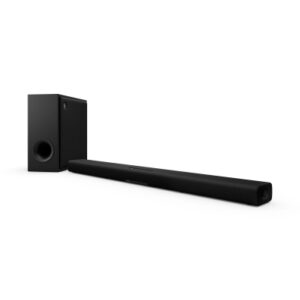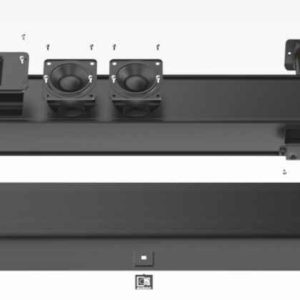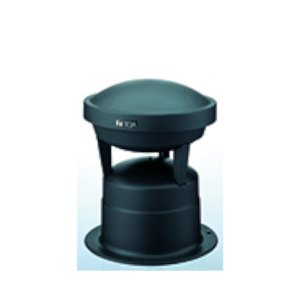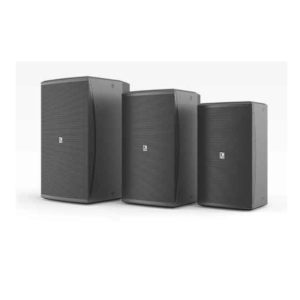Description
1 Display: Shows either an overview of system parameters or level meters for analog inputs, analog outputs, USB I/O, and expansion card I/O. The overview contains limited information
such as IP Address, DHCP Status, and communication LEDs for Ethernet, Dante, and ARC. A short button press moves between the overview and input/output meters. The meters are scaled from -72 dBFS to 0 dBFS. Each segment represents 12 dB. If the signal reaches clipping, the meter will get wider.
2 Wake / Navigation button: A single momentary push button is used to cycle through the Dashboard and System Pages or dismiss a fault notification. A short press scrolls through the menus or dismisses a fault notification and a long press toggles between the Dashboard and System Pages.
3 Power: Accepts power from detachable IEC power cable (100- 240 VAC, 50-60 Hz, 60 Watts max). Connect only to a grounded power outlet.
4 ARC: Distributes power and RS-485 data to one or more ARC devices.
5 A & B Ethernet Ports: 1000 Base-T Ethernet ports for Composer host control, and third-party accessory controllers over IP. Features auto-crossover sensing for direct device-to-device
connections.
6 C & D Dante Ports: 1000 Base-T Ethernet ports provides 128 (64×64) channels of Dante network audio.
7 USB Audio: A USB 2.0 audio I/O interface with Class 1.0 legacy profiles on a high-retention Type B connection for interfacing with soft codecs, recording and playback software, etc. on Windows, Mac or Linux platforms. Configurable for up to 8×8 line I/O as well as 2×2 line I/O, 1×1 speakerphone, or 1×1 echo cancelling speakerphone profiles.
8 RS-232: Serial communications interface for a third-party accessory controller. Tx = Transmit or data out, Rx = Receive or
data in. Port Settings: 57.6 kbaud (default), 8 data bits, 1 stop bit, no parity, no flow control.
9 Factory Reset Switch: To be used under the supervision of technical support, it has the ability to reset the unit’s network configuration and completely reset the unit to factory defaults.
10 Logic Outputs: Eight (8) logic outputs with four (4) paired common ground pins. Logic Outputs go low (0V) when active and are internally pulled high (5V) when inactive and can drive external LED indicators directly.
11 External Control Inputs: Four (4) analog control inputs able to be used as 4 potentiometer inputs or as 8 switch inputs (+3.3 VDC
reference voltage supplied).
12 Analog Line Outputs: Eight (8) balanced analog line level audio outputs, with individually software-controllable +/- 24 dB of digital trim and mute.
13 Expansion Card Slot: I/O card slot accepts any of the available cards providing up to 4 channels of local I/O. Please refer to individual I/O card data sheets for details.
14 Analog Mic/Line Inputs: Twelve (12) balanced analog audio inputs, with individually software-controllable pre-amp gain, +/- 24 dB of digital trim, phantom power, signal inversion and mute.




Architect & Engineer Specifications : Symetrix Radius NX 12×8 The device shall provide twelve analog mic/line inputs that are adjustable from line to mic level with coarse gain, fine trim, phantom power, invert and mute, and 8 analog line outputs that are adjustable with fine gain and mute. All signal processing, mixing and routing functions (including I/O levels) shall be controllable via software. Audio inputs and outputs shall be accessed via rear panel 3.81 mm terminal block connectors. An option card slot may accommodate either a 2 line VoIP interface card, 2 line analog telephone interface card, 4 channel digital input card, 4 channel digital output card, 4 channel mic/line input card, 4 channel AEC input card, 4 channel analog output card, 8×8 USB audio I/O card, or remain empty. An internal DSP coprocessor module may be installed for additional application-specific processing such as acoustic echo cancellation (AEC).
A USB 2.0 audio I/O port with class 1.0 legacy modes on a high-retention Type B connection is configurable for up to 8×8 line I/O as well as 2×2 line I/O, 1×1 speakerphone, or 1×1 echocancelling speakerphone profiles. Network audio expansion shall be provided by the Dante protocol with a capacity of 128 (64×64) channels. Primary and Secondary Dante network audio connections shall be provided for redundant network implementation. Connectors shall be 1000 Base-T RJ45 utilizing CAT6 cable.
A designer software application shall be provided that operates on a Windows computer, with network interface installed, running Windows 7® or higher operating system. Computer
connection for configuration shall be via the device’s rear panel Ethernet connector. All internal processing shall be digital (DSP). Available DSP components shall include (but not
be limited to) various forms of: mixers, equalizers, filters, crossovers, dynamics/gain controls, routers, delays, remote controls, meters, generators, onboard logic, and diagnostics.
The front panel shall include a display and a momentary switch. The display shall provide communications and system status, I/O metering, and fault messages.
External control shall include dedicated software screens as well as preset selection, I/O level control and muting using the optional ARC wall panel remote controls via industry-standard
CAT5 cable with RJ45 connectors. A built-in web server shall provide four instances of ARC-WEB, which allows for user control from nearly any web browser or mobile device.
Logic I/O shall consist of eight contact closures or four potentiometer inputs along with eight logic outputs. The logic outputs may be used to drive LEDs directly or control external relays
or switchers. All program memory shall be non-volatile and provide program security should power fail. The device shall provide an on board real time clock to facilitate automatic, timed changing of presets and may sync to NTP. Third-party control systems may interface over IP and RS-232 using a published ASCII control protocol.
Audio conversion shall be 24-bit, 48 kHz and internal processing shall be 32-bit or 40-bit floating point, 48 kHz. The dynamic range shall not be lower than 115 dB, A-weighted with a
maximum input level of +24 dBu and maximum output level of +24 dBu. The device shall have an IEC power input socket for 120-240 VAC. The device shall meet UL/
CSA and CE safety requirements and comply with CE and FCC Part 15 emissions limits. The device shall be RoHS compliant. The chassis shall be constructed of Galvalume and molded plastic, and mount into a standard 19” 1U EIA rack using detachable rack ears. The device shall be a Symetrix Radius NX 12×8.




